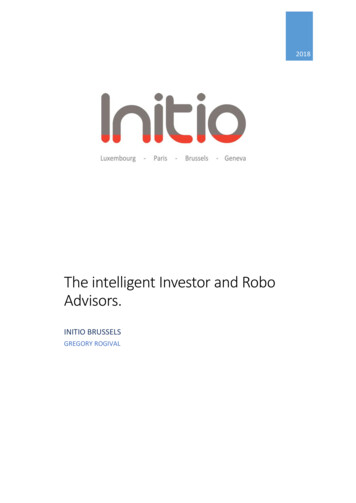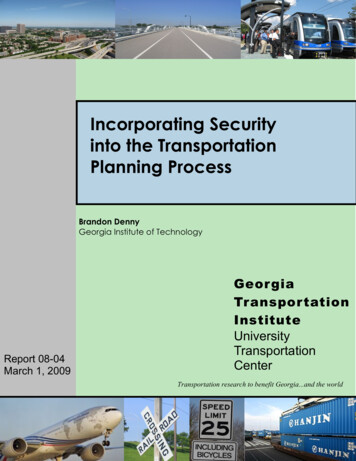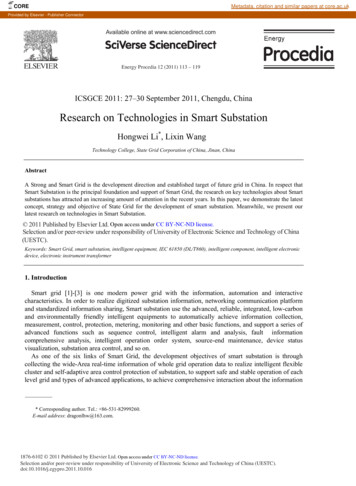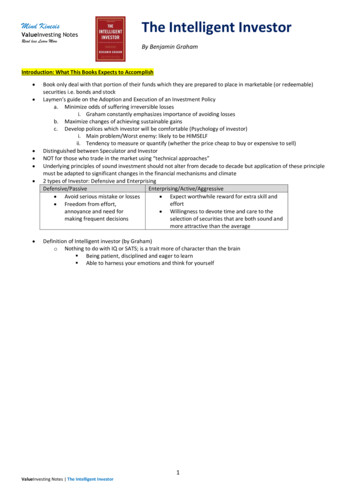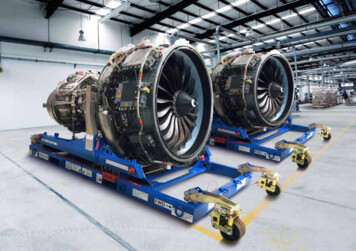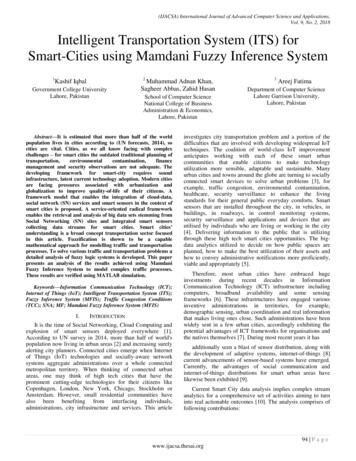
Transcription
(IJACSA) International Journal of Advanced Computer Science and Applications,Vol. 9, No. 2, 2018Intelligent Transportation System (ITS) forSmart-Cities using Mamdani Fuzzy Inference System12Kashif IqbalGovernment College UniversityLahore, PakistanMuhammad Adnan Khan,Sagheer Abbas, Zahid HasanSchool of Computer ScienceNational College of BusinessAdministration & Economics,Lahore, PakistanAbstract—It is estimated that more than half of the worldpopulation lives in cities according to (UN forecasts, 2014), socities are vital. Cities, as we all know facing with complexchallenges – for smart cities the outdated traditional planning emanagement and security observations are not adequate. Thedeveloping framework for smart-city requires soundinfrastructure, latest current technology adoption. Modern citiesare facing pressures associated with urbanization andglobalization to improve quality-of-life of their citizens. Aframework model that enables the integration of cloud-data,social network (SN) services and smart sensors in the context ofsmart cities is proposed. A service-oriented radical frameworkenables the retrieval and analysis of big data sets stemming fromSocial Networking (SN) sites and integrated smart sensorscollecting data streams for smart cities. Smart cities’understanding is a broad concept transportation sector focusedin this article. Fuzzification is shown to be a capablemathematical approach for modelling traffic and transportationprocesses. To solve various traffic and transportation problems adetailed analysis of fuzzy logic systems is developed. This paperpresents an analysis of the results achieved using MamdaniFuzzy Inference System to model complex traffic processes.These results are verified using MATLAB simulation.Keywords—Information Communication Technology (ICT);Internet of Things (IoT); Intelligent Transportation System (ITS);Fuzzy Inference System (MFIS); Traffic Congestion Conditions(TCC); SNA; MF; Mamdani Fuzzy Inference System (MFIS)I.INTRODUCTIONIt is the time of Social Networking, Cloud Computing andexplosion of smart sensors deployed everywhere [1].According to UN survey in 2014, more than half of world'spopulation now living in urban areas [2] and increasing surelyalerting city planners. Connected cities emerge when Internetof Things (IoT) technologies and socially-aware networksystems aggregate administrations over a whole connectedmetropolitan territory. When thinking of connected urbanareas, one may think of high tech cities that have theprominent cutting-edge technologies for their citizens likeCopenhagen, London, New York, Chicago, Stockholm orAmsterdam. However, small residential communities havealso been benefiting from interfacing individuals,administrations, city infrastructure and services. This article3Areej FatimaDepartment of Computer ScienceLahore Garrison University,Lahore, Pakistaninvestigates city transportation problem and a portion of thedifficulties that are involved with developing widespread IoTtechniques. The coalition of world-class IoT improvementanticipates working with each of these smart urbancommunities that enable citizens to make technologyutilization more sensible, adaptable and sustainable. Manyurban cities and towns around the globe are turning to sociallyconnected smart devices to solve urban problems [3], forexample, traffic congestion, environmental contamination,healthcare, security surveillance to enhance the livingstandards for their general public everyday comforts. Smartsensors that are installed throughout the city, in vehicles, inbuildings, in roadways, in control monitoring systems,security surveillance and applications and devices that areutilised by individuals who are living or working in the city[4]. Delivering information to the public that is utilizingthrough these high tech smart cities opportunities. The bigdata analytics utilized to decide on how public spaces areplanned, how to make the best utilization of their assets andhow to convey administrative notifications more proficiently,viable and appropriately [5].Therefore, most urban cities have embraced hugeinvestments during recent decades in InformationCommunication Technology (ICT) infrastructure includingcomputers, broadband availability and some sensingframeworks [6]. These infrastructures have engaged variousinventive administrations in territories, for example,demographic sensing, urban coordination and real informationthat makes living ones close. Such administrations have beenwidely sent in a few urban cities, accordingly exhibiting thepotential advantages of ICT frameworks for organisations andthe natives themselves [7]. During most recent years it hasadditionally seen a blast of sensor distribution, along withthe development of adaptive systems, internet‐of‐things [8]current advancements of sensor-based systems have emerged.Currently, the advantages of social communication andinternet‐of‐things distributions for smart urban areas havelikewise been exhibited [9].Current Smart City data analysis implies complex streamanalytics for a comprehensive set of activities aiming to turninto real actionable outcomes [10]. The analysis comprises offollowing contributions:94 P a g ewww.ijacsa.thesai.org
(IJACSA) International Journal of Advanced Computer Science and Applications,Vol. 9, No. 2, 20181) Analysis of thousands of traffic blockage cases, roadcapacity measures, traffic signalling and dynamic, consistentinformation to give a better message to the citizens.2) Events, episodic road examination, utilising real-datagathered by citizens, devices and sensors.3) Turning web-based into social media information,important city events analysis, assumptions, examinations,and numerous other things. Consolidating information fromphysical (sensors/devices) and social sources (socialorganisations) can give full, essential information and adds tobetter assessment and bits of knowledge.Over-all speaking, smart cities realization is a broadconcept so, the transportation sector is focused in this article.Fuzzy logic is one of the strongest candidate solution formathematical based modelling. In this article fuzzy logicbased solution is proposed for transportation problem. Theinput parameters are: Vehicular Speed (VS), Road Capacity(RC), Traffic Signals (TS), Trip Riding Distance (RD) andDistance Traffic Signals (DTS). A detailed Transportationfuzzy logic system is developed based on rule-basedinferencing to solve the traffic congestion issues. Analysis ofthe results obtained using Mamdani Fuzzy Inference System isverified using MATLAB SimulationThe objective of this paper is to analysis key issues and thesolutions about traffic congestion in a smart city in the light ofcritical inducing aspects. The rest of the paper is structured asfollows: Section II gives an overview of related and similarworks that can be found in the international literature. SectionIII presents the fundamental architecture and approach.Sections IV and V presents technical details, sentimentanalysis of problems and a conceptual model for smart-cities.Section VI provides a proposed Mamdani Fuzzy InferenceSystem (MFIS) based results analyses, the work is planned inthe context of simulation and Section VII contains conclusionand future work to be planned in the context of smart drivemobile apps.II.LITERATURE REVIEWA smart IoT system which automatically notifies necessaryinformation of passengers after triggering of shock detectorsensors to lowering loss rates in accidents and alert nearbylocal public safety organization about the physical location ofaccident suggested by Nasr et al. [11]. Rizwan et al.industrialize a smart traffic management system roadside unit.It carries alternate routing to avoid traffic blocking andincrease traffic flow through IoT and lower traffic density,offers predictive analytic technique (Big-data techniques)[12]. Scalable Enhanced Road Side Unit, SERSU, proposedby Al-Dweik et al. used wireless communication network andradio frequency adaptive traffic control system, pollutiondetection system and weather information system. SERSUcomponents were placed on the roadsides with various breaks,capturing generated sensor signals by vehicle sensors module[13]. Modern techniques in cars, internet and their current andfuture relationship, detail history of usage of electronicdevices in automobiles, and social implication of thesetechnologies briefly studied by Goggin [14]. Joshi et al. madeinfrared-based sensor system, which to monitor traffic flowand provides alternate road traffic routing path to drivers forthe avoidance of traffic crowding capture infrared radiationsemitted by vehicles on road surface [15]. Handte et al.designed IoT enabled the navigational system for realtransport facility, provided complete guidance of routes to busriding passengers for urban bus riders in Madrid, which wereassisting in micro-navigation, expects massive aware routes. Asystem to communicate with onboard sensors to sense thepresence of onboard passengers, this system was based onmobile devices. Their system collected real-world bus user’sresponse for better accessibility of travel information [16].Zanella et al. advised web-based service approach for IoTservice architecture to resolve integration issues for differentend node devices connected to IoT system Zanella et al. alsoevaluated key ideas, facilities and solution are currentlyavailable for implementation of IoT based smart cities [4].Technological challenges and socio-economic opportunities indeveloping and designing of future smart cites discussed keyby Theodoridis et al., they also suggested 3-tier IoT nodes and3-plane architecture model. Further, they develop a city scaletest bed for future internet and IoT experimentation [17]. Ahierarchy which combines smart homes and smart citiesdescribed by Skouby et al., they also proposed a four-layeredmodel to join end nodes IoT devices, communicationtechnologies like distributed artificial intelligence and cloud ofthings [6]. Gubbi et al. presented Radio FrequencyIdentification (RFID’s) a user-centric cloud-based vision ofimplementation of IoT, by the interaction of public and privateclouds, major research trends, IoT application domain, currentand future enabling technologies etc. that will drive IoTshortly [14]. Base Station arrangement, based architecturesensor system for intelligent traffic light system (TLS)suggested by Chong et al. They designed intelligent software,implemented on TLS which continuously communicates withthe base station and calculates green light time, and providemonitoring of traffic by officers [18].Internet of Vehicle (IoV), a unique solution for smarttraffic management is discussed by Dandala et al. They arguedthat IoV can be an effective solution conventional IoT basedtraffic management technique to overcome traditional trafficissues. Further, they described to be a reality which is avehicle to vehicle’s owner that IoV needs four types ofcommunication, a vehicle to vehicle, a vehicle to centralizeserver and vehicle to the third party like police patrol,ambulance, etc. [19]. Cognition was used for userauthentication in vehicles [26]. Sagheer et al. proposed afuzzy inference system to avoid traffic congestion using bioinspired method [27].Density-based signalling to overwhelmed issues raised byfixed time signalling for example in fixed time signallingmethod the traffic lights have predefined periodic time systemsuggested by Thakur et al. provides intelligent signalling byassigning the greener signal to dense traffic region to avoidcongestion by continuously evaluating traffic density [20].Ramchandra et al. proposeddevice traffic lights by usingdynamically according to theproposed system every vehiclea comparable system whichaverage speed of vehiclesdensity of traffic. In thisis equipped with On-Board95 P a g ewww.ijacsa.thesai.org
(IJACSA) International Journal of Advanced Computer Science and Applications,Vol. 9, No. 2, 2018Device (OBD) distribute data to centralise server using Zigbeeprotocol which acquires vehicle speed data process [21].Chowdhury et al. proposed intelligent traffic light systemfor messaging between emergency vehicles infrastructure andto reduce traffic congestion and increase reliability to trafficsignals. The proposed system considers the priority of vehicledepends on the type of incident and to secure signals fromhacking [22]. Some shortcomings in the traditional intelligenttransportation system and argued to prefer Radio FrequencyIdentification (RFID) pointed out by Ou et al., sensor systemand networking technologies to overwhelmed traditionalintelligent transportation systems [23].Information-Centric Networking to project and deviceFuture Internet Architecture proposed by Amadeo et al. InInformation-Centric Networking which uses IoT submissionsto access data of every end node device having uniquelocation name [24].III.SMART-CITY KEY FEATURES REALIZATIONThe availability of smart solutions for cities has risenquickly over the most recent years. Therefore, technicalsolutions exist for each city to become smarter. The challengetoday is mostly to execute proper solutions proficiently, asopposed to just concentrating on innovations. Smart city areascannot be developed through a patchwork approach, yet by thewell-ordered adoption of incremental changes. The mostproper way of smart-city realisation is introducing a smartsystem working group of volunteers characterize itsmanageability vision and afterwards lays out an electronicwell-ordered guide and execution design. The capacity todistinguish the acutest bottlenecks to send coordinated andflexible solutions and afterwards to use these outcomes intoother smart community’s activities requires involvement andstrong specialised expertise.Smart City Key Resources: Transportation, ClimateChange, Energy, Utilities, Security Surveillance, Healthcare,Business Management, etc.Connected cities enhance the experience of workers byanalyzing data and smart city coordinators by breaking downinformation from reporting frameworks including sensors,roadside cameras, brilliant monitoring systems and speedcheck signs. Applying IoT innovations to solve urbancommunity’s issues includes gathering the information that iscollecting from sensors, recordings by cameras, interpersonalorganizations and brilliant devices that are examining realdata. This data is delivered noteworthy bits of knowledge thatare utilized straightforwardly to trigger actuators that areassociated with smart devices. For example, versatile smartcity assets, connected by implications, to illuminate choices onpolicy and to streamline jobs. In smart urban communities,these arrangements include monitoring geographicinformation from Global Positing System (GPS) trackers andRFID labels on vehicles [15], structures, buildings and powerstations, breaking down the proceed of vehicles to recognizeoccurrences or blockages. Smart buildings security,interpersonal organizations, city administrations arestraightforwardly modifying frameworks continuously tocontrol the activity stream in city events, security observationinvestigation and reduce traffic delays. Authentic analysis ofcity traffic, security investigation and movement blockage androadside sensors information can likewise be utilized to altertime delays, misinterpreting security observation, speed cutoffpoints and city toll tax, control security monitoring andactivity stream in the more flows for long-term outcomes. Toroute movement around incidents, sensors additionally writeabout the state of streets conditions, weather updates,buildings structures, road lights and extensions with the goalthat support to schedule maintenance when required.Smart cities will make emerging activities intransportation, utilities, smart buildings and smart security.Smart city design plan leaders shaped a working group ofecosystem system accomplices to evaluate robust citycommunity’s abilities and guide a long-term vision thatcoordinates with the city's future planning. Smart city plannershave endorsed digitalising citywide assets like fast travelframework, smart buildings, smart security, electric transportand is additionally pushing ahead for far-reaching IoT hub thatwill pioneer digital city infrastructure.Designing a roadmap for smart-cities is based on four corepillars: Connectivity is the foundational layer of a smart-city.In real-time data is collected about peoples, places and thingsby smart sensors and this data are stored on cloud applicationservers to analyze and utilised to take better real-timedecisions and planning as shown in Fig. 1.Mobility means moving peoples, goods and informationefficiently and efficiently. The economic-mobility meansregardless of circumstances online job seekers in smart-citiesfind maximum jobs available that are not handy via publictransportation.Next is security improving public and private placessecurity, data protection and cyber-security while using latestICT’s technologies on-line and off-line.Sustainability, of course, is focusing on sustainablepractices in critical sectors of cities such as transportation,energy consumption, climate change, utilities, securityobservations, and financial services.Implementation of smart-cities solutions may have threethings every day for their citizen, i.e., creates values, generatesrevenues and cut costs depending on value exchange smartsystems and smart projects.Fig. 1.Road-map four pillars of a smart-city.96 P a g ewww.ijacsa.thesai.org
(IJACSA) International Journal of Advanced Computer Science and Applications,Vol. 9, No. 2, 2018A. Smart Cities Framework Model OverviewThe adaptive data analysis stage is plotted out in thebackground. It is made out of different layers, bring down alevel (devices, communication planes), middle layers (data,information examination) at higher layers (application,dashboard planes). At each layer, distinctive programmingcode chunks perform specific operations, related to collectingdata, messaging, data accessing, semantic annotation,examination or perception where applications can joinsegments from different layers in light of their specific prerequisites. Along these advances toward getting to be plug andplay and can be mainly used in smart-city sectors applications.The present extraordinary cutting-edge advances of portabilitysmart-phones, interpersonal organization services and objectsare coordinated together for a new time machine to machineand person to person communication correspondence [17].1) Main Components of the ModelThe layered framework model of a smart city as shown inFig. 2 is having four main layers described below as:a) Sensing LayerSensor Layer comprises tens to thousands of sensor hubsconnected using smart remote technologies. They gather datafrom the environment and convey it to other connecteddevices that pass the data to the cloud server over the Internet.b) Communication LayerWireless heart innovative technology gives excellentremote protocol access to the full range of processors capacity,control, and resource management to applications. DigiMeshis an exclusive shared systems networking topology for use inremote end-point network connectivity through the physicalInternet.c) Data LayerThe capacity and processing of data should be possible onthe edge of the networks itself or in a cloud server. If anypreprocessing of data is a need, then it is typically done ateither the sensor or some other proximate device.The processed data is then regularly sent to a remoteserver. The capacity and processing abilities of an IoT objectare additionally controlled by the assets accessible, which areregularly exceptionally compelled because of constraints ofcapacity, vitality, control, and computational ability.d) Application LayerThe application layer is responsible for data organizationand presentation. The application layer on the Internet isregularly in light of Hyper Text Transfer Protocol (HTTP)/File Transfer Protocol (FTP) standards. The proposed eventsin this examination are sharing of dynamic data to customersusing mobile phones as a particular device. It may be HTTP isnot reasonable in resource enabling situations since it isrelatively verbose and this manner brings about a significantparsing overhead. Many other innovative conventions havebeen produced for IoT resources, for example, Message QueueTelemetry Transport (MQTT) and Constrained ApplicationProtocol (CoAP).Along with these four layers following components movetoward becoming plug and play real-time integration andstream-analytics that can be utilized explicitly by specificsmart applications framework by adaption of these technicalmodules given below:a) Data WrapperIt is a program that extracts the content from a particularinformation source and translates it into an organizationformat. Using sensory meta-data, it extends a generic way todescribe features of sensors, about the data stream thatcontaining general information. A semantic annotation moduleannotates the sensory parsed data.b) Data AggregationFor data aggregation, the source information originatesfrom public records online databases. The information ispackaged into aggregate reports this information is useful forbusiness, marketing, local and government organizations. Itreduces the large volume of data, i.e. the size of raw sensoryobservations delivered by the data wrappers by using datacompression techniques and time series analysis.c) Data FederationAnswers to user queries, according to the requirements itfirst finds the relevant stream. It then translates the userrequest into Resource Description Framework-StreamProcessing (RDF-RSP) queries and obtains resultsaccordingly. As fast changing real-world data from sensorsand online services evolves IoT-based smart environmentmonitoring, real-time processing and analytics based on RSPsemantics. RDF query language manages continuous datastreams SPARQL, and CQELS languages support RDFreasoning.Fig. 2.Layered Model of a smart-city.d) Event DetectionThe event detection is the identification of items, eventsand observations, i.e. constraints on what defines an event isrelaxed or usually modelled as a set of thresholds orprobabilities. In city sectors, it provides tools or websoftware’s applications that monitor urban areas events suchas the need for clearing transport deadlock, emergency97 P a g ewww.ijacsa.thesai.org
(IJACSA) International Journal of Advanced Computer Science and Applications,Vol. 9, No. 2, 2018facilities, irrigation facilities, pest identification in crops andgrowing view of the traffic congestion form real-timeannotated and aggregated data streams.IV.CONCEPTUAL FRAMEWORK FOR SMART-CITIESThe proposed technique in this study is sharing of dynamicinformation to users using smartphones as a communicationdevice. Current day advanced modern technologies ofknowledge mobilization, cloud-servers and the smart-city appare integrated into a new era of quick communication.Advanced smart-phones may have limited sensing capabilitiesbut enhanced computational strength, lesser cost, excessiveusage, availability of Global System for Mobilecommunication (GSM) and mobile internet signals,availability of different sensors in smartphones like agyroscope, digital compass, proximity sensor, etc. Servicesavailable like Google map, Google weather, IBM livestreaming analytics etc. is prime motivation to use asmartphone as sensor I/O device in the proposed system.Moreover, specialised and more accurate sensors likeaccelerometer, Global Positioning System (GPS), and shocksensor etc. services are realised. Also, specific and moreaccurate sensors like accelerometer, global positioning system,and amaze sensor so on so forth are outlined and created onvarious stages and new technologies integrating with existingtechnologies in a single integrated system that is beyond thescope of the current proposes a study as shown in Fig. 3.The proposed system aims to provide efficient andeffective smart cities traffic infrastructure. In this study, weshow the concepts of cloud computing, bid-data analysis,internet of things, human-computer interactions, softwareengineering paradigm etc. can be the realization of smartcities traffic framework to improve the living standards oftheir citizens.Studies suggest that smart cities need specific informationfor experiencing globalization by making efficient smart citydecisions like smart transportation, smart energy distribution,demo-graphic information, smart utilities, healthcareservices, etc.Travelers from one city to another city have very littleinformation about nearby pinpoint spatial locations, safetyorganisations, emergency services and government buildingand necessary information for traveller and visitors with them.In case of any emergency situation, even local public safetyorganizations have no personal, medical records or emergencycontact numbers for any situation. On any highways, peopleshesitate to do or accept any help from others travellers orunknown peoples because of no information. To overcomethese issues with smart sensors, surveillance cameras,Wireless Fidelity (Wi-Fi) devices may help the citizen ofsmart-cities by the following critical technical innovations: Users will get real-time and dynamic information aboutthe city routes with other cities in a particular range byGoogle Map as shown in Fig. 4. Smart mobile-appcollected device and personal mobile information fornotification, newsfeeds in text or audio format. Smart city will alert their citizens about roadcongestion in the form of text, audio/video format. Provide necessary information of other cities aroundand also provides a platform to communicate withthese connected cities by text messages. Track record of smart cities user is or travellers fromstart to destination and generates alerts of essentialplaces nearby like fuel stations, restaurants, hospitals,emergency stations, etc. Smart cities are real-data streaming analytics whichprovides complete details of their citizen with utilityservices to transportations facilities. Users can send and receive with one push anyemergency messages to other cities users (usingGSM/GPS, other Internet services) as well as informnearby emergency organizations in the form of anemail as shown in Fig. 5. Users can comfortably offer or accept emergencypickup, health-care services, nearby building info andshare visits from other travellers especially onhighways because smart cities will keep track of theseconnected cities. Reporting of any crime, security surveillance, weatherforecast, misconduct to authorities nearby (ifwitnessed) with proper privacy.Fig. 3.Proposed Model of Smart City App. The user receives text messages as well as audio/videosformat to prevent mental divergence.98 P a g ewww.ijacsa.thesai.org
(IJACSA) International Journal of Advanced Computer Science and Applications,Vol. 9, No. 2, 2018will provide all the necessary computations. Microsoft AzureIoT cloud server will be used because of its enhanced featuresfor smart cities utility services, transportation conditions,environmental conditions and security features realization.V.SOCIAL ANALYSESIn this section social analysis of smart cities as a samplehas been performed in the form of graphical representation. Agraph is a data structure which consisting of a finite number ofedges and nodes. There are many ways to represents a node,edge graph, for example, adjacency matrix, graph ML format,CSV files.The adjacency matrix is a two-dimensional square matrixwhose size is equal to the number of nodes in the graph.However, if input graph contains a large number of nodes andless number of edges then the adjacency matrix became sparseand space consuming. Fig. 6 represents a sample connectedcities graph and Table I represents an adjacency matrix 6*6 ofconnected cities.Fig. 4.Fig. 5.In the graph illustrated in Fig. 6 nodes represent cities atdifferent ranges and edges for instance roads between cities,paths and connectivity or relationship between cities are indifferent ranges.Sample prototype of Smart-Map.Prototype of Smart-City App.Fig. 6.Smart cities users are using user’s smartphone as sensingas well as a communication device. In the proposed systemsmartphones will act as wireless sensor network’s node.Internet and Mobile telecommunication GSM signals will acta medium of communication between all wireless networkedsensor nodes. The application server will host smart-citiesapplication and is connected to Short Message Service (SMS)server which will generate text messages, and it is also aninterface between end nodes and application cloud-server. Theapplication server will also send e-mails to public safetyorganizations in case of an emergency. The application serverConnected smart cities graph.Edges define the relationship between different users orcities resources, a directed edge from city 1 to city 2represents that city one can communicate with city 2 andcity 3. City 2 can communicate with city 5, city 4 and city 3and so on for every city connection in a graphical formathaving close centrality measures. The adjacency matrix isrepresented in Table I in this “0” represents no relationship,and “1” represents the positive relationship. If city one userswant to communicate with city four user’s, they cancommunicate with the help of city two based on shortest pathalgorithm between two nodes traversed.99 P a g ewww.ijacsa.thesai.org
(IJACSA) International Journal of Advanced Computer Science and Applications,Vol. 9, No. 2, 2018TABLE I.VI.ADJACENCY MATRIX BETWEEN CITIES 6 X 6City 1City 2City 3City 4City 5City 6City 1011000City 2101111City 3100100City 4011000City 5010001City 6010010This phenomenon is used on the higher level as well incomputational intelligence. In which every node represents asmart city a cluster of cities and edges represents any one ofcites which can reside or act as the interacti
Chowdhury et al. proposed intelligent traffic light system for messaging between emergency vehicles infrastructure and to reduce traffic congestion and increase reliability to traffic signals. The proposed system considers the priority of vehicle depends on the
